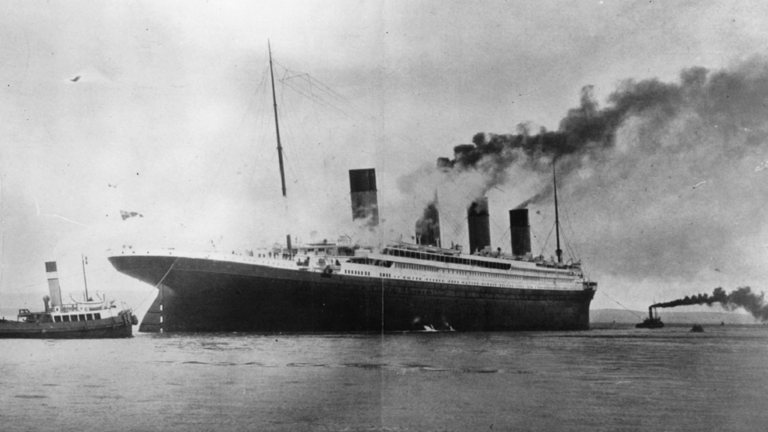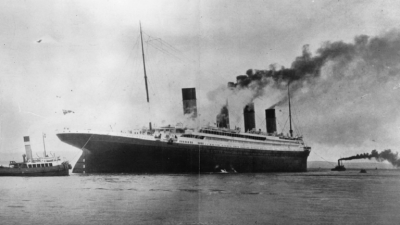More than 100 years after it sank while crossing the Atlantic Ocean on its maiden voyage, the Titanic is still widely regarded as the most famous ship in history. The luxury ocean liner, owned and operated by the British White Star Line, tragically sank in the early hours of April 15, 1912, after hitting an iceberg, resulting in the estimated deaths of about 1,517 of the 2,224 people on board. Its wreck now lies at the bottom of the sea approximately 350 nautical miles off the coast of Newfoundland, Canada, although the delicate wreck is deteriorating rapidly underwater to the extent that it may completely disappear within the next forty years. There are five mysteries surrounding the Titanic, some of which may never be resolved.
**Why was the Titanic moving at such speed?**
It is known that the Titanic was nearly at full speed when observers spotted the iceberg late on April 14, 1912. The ship, deemed "unsinkable," was sailing at about 22.5 knots or 25 miles per hour, just 0.5 knots below its maximum speed of 23 knots. Titanic's Captain, Edward Smith, increased the ship's speed across the Atlantic despite warnings of ice from nearby ships. Why was the ship sailing at such speed through an iceberg-laden area at night with low visibility? In James Cameron's 1997 film "Titanic," White Star Line Chairman Bruce Ismay is portrayed pressuring Captain Smith to increase speed to reach New York by the deadline and "make headlines." This scene was based on actual testimony from first-class passenger and survivor Elizabeth Lindsey Leans, who testified after the sinking. Her testimony indicated that Ismay wanted the ship to break the record set by RMS Olympic during its maiden voyage from Southampton to New York the previous year. However, Royal Museums Greenwich claims that stories of the captain seeking to break a speed record are "without substance," despite Leans' account. Another theory proposed by an American engineer in 2004 suggests that a coal fire burning deep within the Titanic necessitated that the ship reach New York faster than originally planned. According to Robert Essenhigh from Ohio State University, Titanic's records show there was a fire in one of the coal stores, specifically coal bunker number 6. He stated that increasing the rate of coal removal from this bunker and feeding it into the boilers would have allowed the crew to control the fire while also speeding up the ship. Essenhigh argued that Titanic's crew would not have been attempting to break any transatlantic records because the ship was designed for comfort, not speed, and was advertised as such prior to its voyage. This theory was reiterated in the 2017 documentary "Titanic: The New Evidence" by Irish journalist Sinan Maloney, who stated that Titanic "should never have been launched" due to the fire weakening its hull.
**Did the SS Californian ignore Titanic’s distress calls?**
After the Titanic struck the iceberg and it became clear that the ship was sinking, Captain Smith ordered his crew to light flares and send wireless messages to nearby ships in hopes of receiving help. The closest ship in the vicinity was SS Californian, a smaller steamer bound for Boston, Massachusetts, captained by Stanley Lord. It had no passengers and would have had ample space for those on Titanic. Due to the threat of "ice," Lord halted Californian late at night at around 10:20 PM on April 14, about 80 minutes before Titanic struck the iceberg. At that time, Californian was recorded to be about 19 miles northeast of Titanic, although a later British inquiry into the disaster concluded it was much closer—about six miles away. Californian was also closer than RMS Carpathia, which sailed 58 miles through treacherous icy waters to rescue Titanic's survivors. Unfortunately, Carpathia arrived two hours after Titanic sank, but Californian could have arrived sooner—why didn’t that happen? Earlier that evening, before Titanic struck, Californian's wireless operator, Cyril Evans, contacted Titanic to warn of ice. The message was received by Jack Phillips, the wireless operator on Titanic, who asked Evans to "shut up" as he was busy sending passenger messages from Cape Race, a relay station 800 miles away. Evans, possibly feeling insulted by the brusque reprimand, turned off his wireless equipment and went to bed, thus failing to receive the urgent wireless messages from Titanic that followed. However, this does not explain why the crew on Californian did not investigate the flares they saw launched—particularly since they knew Titanic was nearby. Californian's second officer, Herbert Stone, reported seeing several flares and informed Captain Lord, but at this stage of the story, evidence from the inquiry regarding this is often murky and contradictory. It is said that Stone indicated at the time, "The ship wouldn't launch flares for nothing," but later told the inquiry, "I thought the ship might be in contact with another vessel, or perhaps it was telling us there were large icebergs around.” Stone relayed information about the flares to Captain Lord, but ultimately the captain took no action—a decision that undoubtedly cost lives. The role of Californian that night was not portrayed in James Cameron's 1997 epic, but it featured prominently in the 1958 British film "A Night to Remember."
**How did the baker survive?**
One of the most compelling survival stories from the Titanic is that of Charles Joughin, a 33-year-old chief baker from Cheshire. Joughin—who ordered his crew to prepare lifeboats with bread as rations—was on board Titanic until the moment the ship was submerged. He moved to the back of the Titanic (the stern) and held onto the railing, which kept him on the ship's exterior, where it descended from the bow. He told the British inquiry, "I don't think my head ever went underwater at all. It may have got wet, but no more than that." In Cameron's film, he is depicted standing on the stern rail, alongside fictional characters Jack (Leonardo DiCaprio) and Rose (Kate Winslet). Amazingly, Joughin managed to survive despite being in the water for almost two hours, even though the temperature was below freezing (28 degrees Fahrenheit or -2 degrees Celsius). Most who entered the water died from hypothermia within 30 minutes—how did he survive?
The baker later stated he had been drinking spirits before the ship sank, and one theory is this helped keep him warm in the water later on—but a 2018 study suggests this is unlikely. Despite the common belief that alcohol warms the body, it has been shown that alcohol consumption decreases body temperature in cold weather, exacerbating the risk of hypothermia, it claims. It is also believed that Joughin maintained a calm demeanor and continuous movement in the water increased his chances of survival. After about two hours of "paddling," as he put it, Joughin was pulled onto a capsized lifeboat B with no ill effects aside from a swollen foot. Joughin later emigrated to the United States before passing away in 1956 at the age of 78.
**Why weren't there enough lifeboats?**
It is known that the Titanic did not have enough lifeboats to accommodate all 2,224 souls on board. If it had, many hundreds—if not all—of the lives lost that night could have been saved. Titanic had a total of 20 lifeboats, which could hold 1,178 people, just over half the total (although two of these boats were never launched when the ship sank). There are various explanations for why there were not more. First, it was said that Titanic's designers felt that too many lifeboats would clutter the deck and obstruct first-class passengers' views of the sea. Looking at Titanic's layout, lifeboats were mostly kept on the officers' promenade towards the front and the second-class promenade towards the back. Meanwhile, the first-class promenade was almost entirely free of lifeboats, allowing first-class passengers to stroll and enjoy unobstructed views of the Atlantic Ocean on both sides. Although it seems unimaginable now, Titanic's points of distinction were clearly its grandeur and luxury, not its safety. Additionally, it was not expected that Titanic would need her lifeboats to accommodate all passengers at once. Instead, if Titanic encountered any trouble, lifeboats were to be used to ferry passengers from Titanic to a rescue ship. Tragically, many of the lifeboats launched from Titanic were not filled to capacity, as some crew members mistakenly believed they could not bear the weight. It is noteworthy that Titanic's outdated safety regulations concerning lifeboats had originated nearly 20 years earlier when the largest passenger ships weighed 10,000 tons. Weighing just over 46,000 tons, Titanic was more than four times that figure. Perhaps more than anything else, it was not expected for Titanic to fail; a White Star Line brochure from 1910 regarding Titanic and the Olympic read: "These two magnificent ships are designed to be unsinkable." Captain Smith himself stated, "I cannot conceive of any condition that would cause a ship to flounder. I cannot imagine any catastrophe necessitating life-saving measures for this ship. Modern shipbuilding has overcome all that."
**What happened to Captain Smith?**
Captain Edward Smith died on the night the Titanic sank, but what exactly happened to him is a much bigger mystery. Smith—who planned to make Titanic his final voyage before retirement—"went down with the ship," which was a maritime tradition at the time. However, there are several different accounts from survivors regarding where he was last seen and how he died. In Cameron's 1997 film, Smith, played by English actor Bernard Hill, is shown locking himself in the wheelhouse on Titanic's bridge as it fills with water, based on the testimony of some survivors. One of them, first-class passenger Robert Williams Daniel, stated, "I saw Captain Smith on the bridge. It seemed like my eyes were fixed upon him. The deck I jumped from was submerged. The water was slowly rising, now reaching the floor of the bridge. Then it was at the captain’s waist. I never saw him again. He died a hero." Other survivors, including wireless operator Harold Bride, claimed to have seen him jumping from certain parts of the ship, while others said Smith swam to the lifeboats holding a baby. Smith's body was never recovered.




